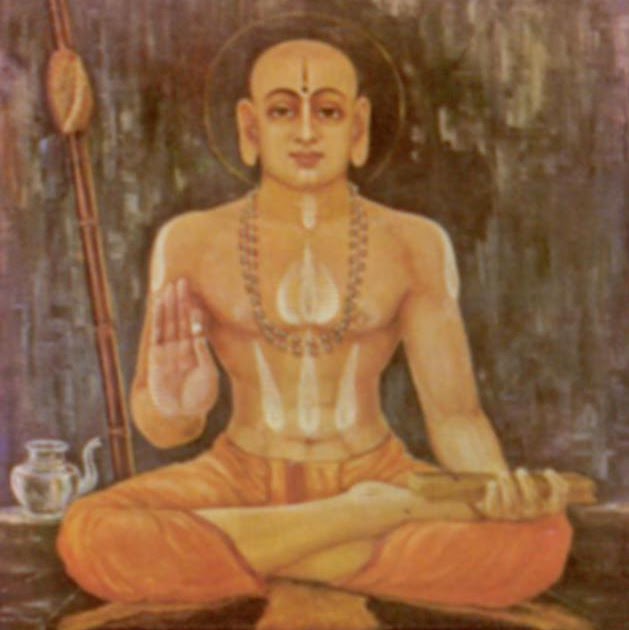- English Commentary : Hunsur Sriprasad, New Jersey
ದಂಭೋಲಿತೀಕ್ಷ್ಣನಖ ಸಂಬೇಧಿತೇಂದ್ರರಿಪು ಕುಂಭೀಂದ್ರ ಪಾಹಿ ಕೃಪಯಾ |
ಸ್ತಂಭಾರ್ಭಕಾಸಹನ ಡಿಂಭಾಯ ದತ್ತವರ ಗಂಭೀರನಾದ ನೃಹರೇ |
ಅಂಭೋದಿಜಾನುಸರಣಾಭೋಜಭೂ ಪವನ ಕುಂಭೀನಸೇಶ ಖಗರಾಟ್ |
ಕುಂಭೀಂದ್ರ ಕೃತ್ತಿಧರ ಜಂಭಾರಿ ಷಣ್ಮುಖ ಮುಖಾಂಭೊರುಹಾಭಿನುತ ಮಾಮ್ || 8 ||दंभोलितीक्ष्णनख संबेधितेंद्ररिपु कुंभींद्र पाहि कृपया ।
स्तंभार्भकासहन डिंभाय दत्तवर गंभीरनाद नृहरे ।
अंभोदिजानुसरणाभोजभू पवन कुंभीनसेश खगराट् ।
कुंभींद्र कृत्तिधर जंभारि षण्मुख मुखांभॊरुहाभिनुत माम् ॥ 8 ॥daMBolitIkShNanaKa saMbedhiteMdraripu kuMBIMdra pAhi kRupayA |
staMBArBakAsahana DiMBAya dattavara gaMBIranAda nRuhare |
aMBodijAnusaraNABojaBU pavana kuMBInaseSa KagarAT |
kuMBIMdra kRuttidhara jaMBAri ShaNmuKa muKAMBOruhABinuta mAm || 8 ||
Padachcheda:
daMbholi tIxNa nakha saMbhedita indra ripu kuMbhIndra pAhi kR^ipayA
staMbha arbhaka asahana DiMbhAya datta vara gaMbhIra nAda nR^ihare
aMbhodija anusaraNa aMbhojabhU pavana kuMbhIna sesha khagarAT
kuMbhIndra kR^itti dhara jambhAri ShaNmukha mukha aMbhoruha abhinuta mAm
Anvaya:
daMbholi tIxNa nakha saMbhedita indra ripu kuMbhIndra
staMbha arbhaka asahana DiMbhAya datta vara gaMbhIra nAda
aMbhodija anusaraNa aMbhojabhU pavana kuMbhIna sesha khagarAT
kuMbhIndra kR^itti dhara jambhAri ShaNmukha mukha aMbhoruha abhinuta
nR^ihare kR^ipayA mAm pAhi
Word-by-word meaning:
daMbholi = vajrAyudha (thunderbolt) = the main weapon of Indra, tIxNa = sharp, nakha = nails, saMbhedita = pierced or shredded, indraripu = indra’s enemy i.,e HiranyAksha, kuMbhIndra = (wild and untamed) elephant king, staMbha arbhaka = pillar’s child (staMbha = pillar, arbhaka = a child or offspring), asahana = intolerant (one who will not tolerate or pardon enemies), DiMbhAya = for the sake of the child (Prahlada, son of HiranyaKashipu), dattavara = one who has given boons, gaMbhIra = deep or resonant, nAda = tone, aMbhodija anusaraNa = one who is followed by Lakshmi (aMbhodijA = daughter of the ocean i.e, Lakshmi, anusaraNa = followed by), aMbhojabhU = one born out of a lotus (brahma), pavana = vAyu, kuMbhInasesha = Adisesha (kuMbhInasa = snakes, Isha = king), khagarAT = Garuda (khaga = birds, rAT = king), kuMbhIndrakR^ittidhara = one who wears the skin of the king of elephants = Rudra (kuMbhIndra = king of elephants, kR^itti = skin or hide, dhara = wearing), jambhAri = enemy of jambhAsura = Indra, shaNmukha = Subramanya, mukha aMboruha = lotus face, abhinuta = respectfully saluted or worshipped, nR^ihare = Oh Narasimha , kR^ipayA = with mercy, mAm = me, pAhi = protect.
Translation:
O Lord Narasimha, your sharp nails are like (separate) thunderbolts. They shred HiranyAksha, who was Indra’s enemy and uncontrollable like a wild, untamed elephant king. You were born out of a pillar. You do not tolerate enemies (your enemies, as well as enemies of your devotees). You gave boons to child Prahlada. You have a deep, resonant roar. You are followed by the daughter of the Ocean (Lakshmi). Great people like the one born from a lotus (Brahma), Pavana, Sesha, the kings of birds (Garuda), the one who wears the skin of the king of elephants (Rudra), the enemy of jambhAsura (Indra), shaNmukha worship you with reverence through their lotus-like faces. Take pity on me and protect me.
Notes:
The first portion of the verse is a reiteration of nakha stuti. Like Acharya Madhva, Sri VadirAja compares each nail of Narasimha to a separate thunderbolt. He also uses the same metaphor of the lion killing elephants by striking their kumba stala.
The term ‘Stambha’ is also an epithet of Vishnu (in the VishnusahasranAma, he is called ‘stambho bhAvano bharta …’). In addition, it has several meanings, each of which describes one or more qualities of the Lord. For example, one meaning is ‘motionless’. Since He is omnipresent, He is motionless. This thought is echoed in several upanishads. So ‘stambhArbhaka’ means that He is born out of Himself i.e, AtmayOni, swayamjAta (also names in the VSN).
‘Followed by Lakshmi’ goes beyond a wife dutifully following her husband. It means that She is always with Him and there is no time or space where they are not toegher. It also means that she follows Him in tAratamya or hierarchy. Also, it must be remembered that she is the abhimAni for Prakruti, Vedas and the 3 gunas (satva, rajas, tamas) too. Thus, all these entities too follow Him or act according to His desire.
“aMbhodija anusaraNa aMbhojabhU pavan …” can be taken together too. This refers to the fact that when Brahma and other gods saw Narasimha’s ferocious form, they pretended to be scared and requested Lakshmi to pacify Him; they stayed behind Her when approaching Him. Acharya Madhva comments that this is all a pretense done by devatas to highlight Prahalada and show him a good light.
deva nR^isimha hiraNyakashatro sarva bhayA.ntaka daivataba.ndho |
atibaladitisuta hR^idaya vibhedana jayanR^ihare.amala bhava mama sharaNam |
